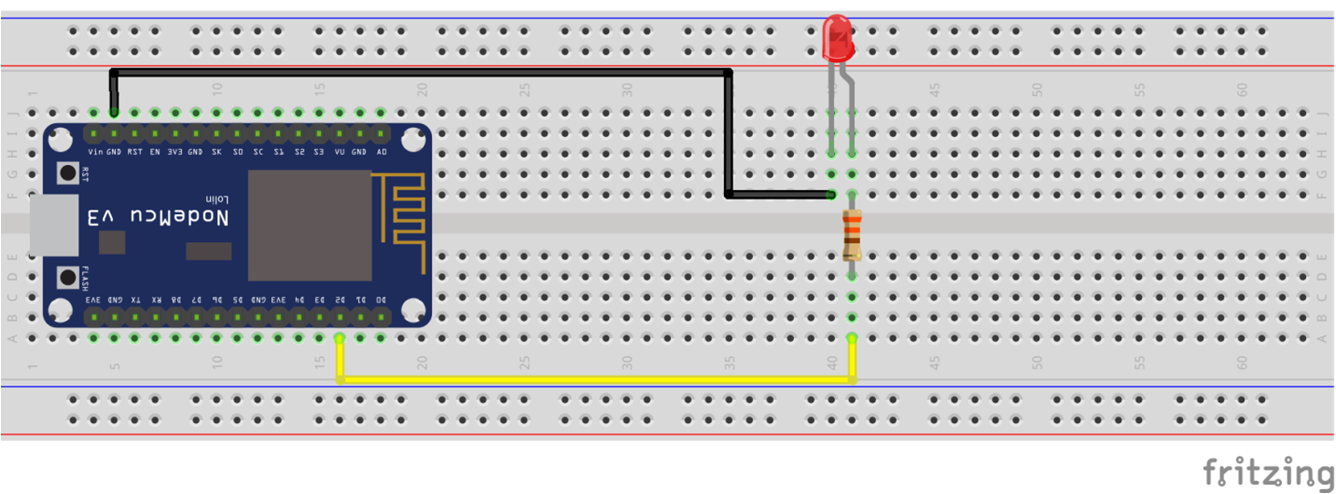In this article we will learn how to implement Web Server LED with NodeMCU ESP8266. If your are new to Internet of Things (IoT), learn about IoT by visiting our Internet of Things tutorial for beginners.
Contents
Aim of Experiment
To create a local server that controls an LED using NodeMCU.
Components Required
- NodeMCU – 1
- LED – 1
- 330Ω Resistor – 1
- Breadboard – 1
Connections Diagram (Schematic)
Code (C++/Arduino IDE)
#include <ESP8266WiFi.h>
#include <ESP8266WebServer.h>
/* Put your SSID & Password */
const char* ssid = "NodeMCU"; // Enter SSID here
const char* password = "12345678"; //Enter Password here
/* Put IP Address details */
IPAddress local_ip(192,168,2,1);
IPAddress gateway(192,168,2,1);
IPAddress subnet(255,255,255,0);
ESP8266WebServer server(80);
uint8_t LEDpin = D2;
bool LEDstatus = LOW;
void setup() {
Serial.begin(9600);
pinMode(LEDpin, OUTPUT);
WiFi.softAP(ssid, password);
WiFi.softAPConfig(local_ip, gateway, subnet);
delay(100);
server.on("/", handle_OnConnect);
server.on("/ledon", handle_ledon);
server.on("/ledoff", handle_ledoff);
server.onNotFound(handle_NotFound);
server.begin();
Serial.println("HTTP server started");
}
void loop() {
server.handleClient();
if(LEDstatus)
digitalWrite(LEDpin, HIGH);
else
digitalWrite(LEDpin, LOW);
}
void handle_OnConnect() {
LEDstatus = LOW;
server.send(200, "text/html", SendHTML(false));
}
void handle_ledon() {
LEDstatus = HIGH;
server.send(200, "text/html", SendHTML(true));
}
void handle_ledoff() {
LEDstatus = LOW;
server.send(200, "text/html", SendHTML(false));
}
void handle_NotFound(){
server.send(404, "text/plain", "Not found");
}
String SendHTML(uint8_t led){
String ptr = "<!DOCTYPE html>\n";
ptr +="<html>\n";
ptr +="<head>\n";
ptr +="<title>LED Control</title>\n";
ptr +="</head>\n";
ptr +="<body>\n";
ptr +="<h1>LED</h1>\n";
ptr +="<p>Click to switch LED on and off.</p>\n";
ptr +="<form method=\"get\">\n";
if(led)
ptr +="<input type=\"button\" value=\"LED OFF\" onclick=\"window.location.href='/ledoff'\">\n";
else
ptr +="<input type=\"button\" value=\"LED ON\" onclick=\"window.location.href='/ledon'\">\n";
ptr +="</form>\n";
ptr +="</body>\n";
ptr +="</html>\n";
return ptr;
}
Video Explanation
References

Suryateja Pericherla, at present is a Research Scholar (full-time Ph.D.) in the Dept. of Computer Science & Systems Engineering at Andhra University, Visakhapatnam. Previously worked as an Associate Professor in the Dept. of CSE at Vishnu Institute of Technology, India.
He has 11+ years of teaching experience and is an individual researcher whose research interests are Cloud Computing, Internet of Things, Computer Security, Network Security and Blockchain.
He is a member of professional societies like IEEE, ACM, CSI and ISCA. He published several research papers which are indexed by SCIE, WoS, Scopus, Springer and others.


Leave a Reply